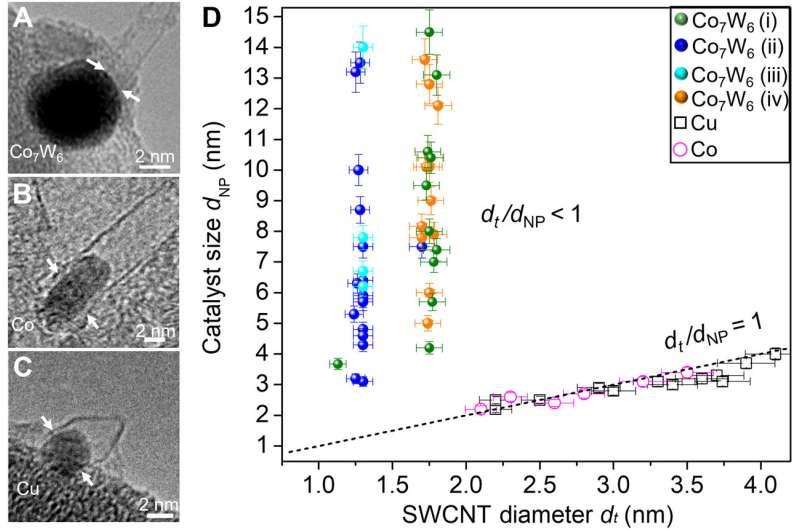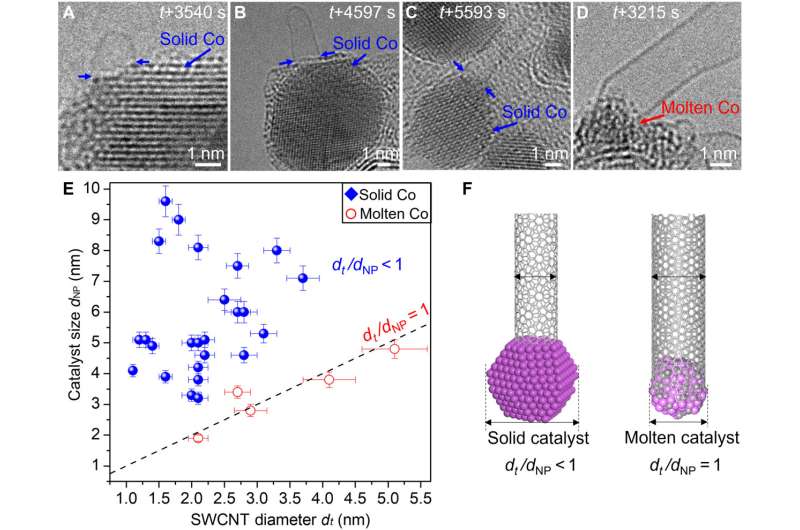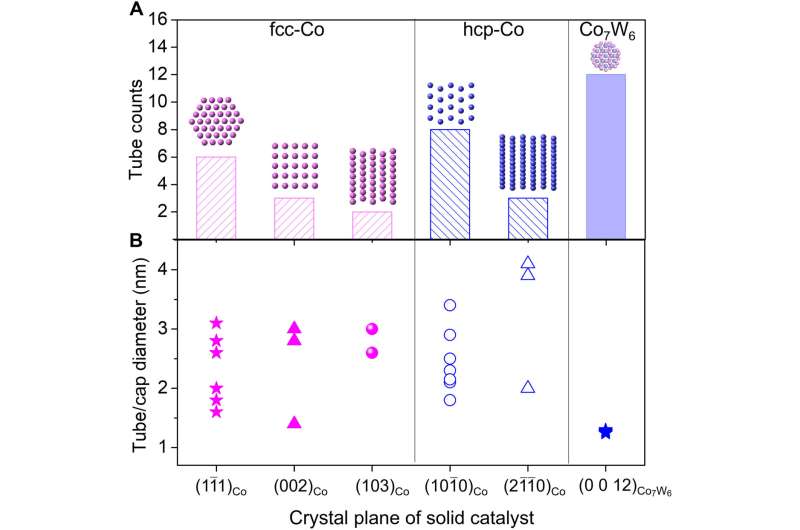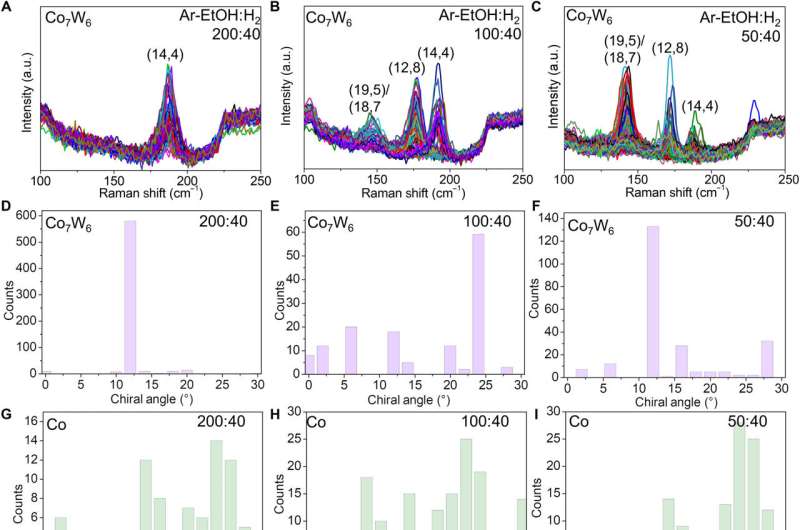November 14, 2022 feature
Understanding the growth modes of single-walled carbon nanotubes on catalysts
![Aberration-corrected ETEM characterization of SWCNTs grown from an intermetallic Co7W6 catalyst. (A and B) Time-sequential ETEM images of SWCNT cap nucleated from solid intermetallic Co7W6 catalysts at 1000°C under CH4 (50 Pa). Inset: The FFT of the seeded Co7W6 catalyst along the [1 1¯ 0] direction. (C) Scheme showing an SWCNT cap nucleating from the atomic edge of Co7W6 (001). The Co7W6 nanocrystal is along the [1 1¯ 0] direction. (D and E) Other cap and SWCNT grown on the surface of Co7W6 catalysts captured by ETEM. FFT patterns of SWCNT and Co7W6 catalyst derived from TEM image (E). Simulated (16,0) SWCNT and Co7W6 [ 1¯5¯ 1] were also shown (E). Credit: Science Advances (2022). DOI: 10.1126/sciadv.abq0794 Understanding the growth modes of single-walled carbon nanotubes on catalysts](https://scx1.b-cdn.net/csz/news/800a/2022/understanding-the-grow.jpg)
Insights into the catalyst structure-function relationship of single-walled carbon nanotubes (SWCNTs) can provide an outlook to their growth mechanisms. In a new report now published in Science Advances, Feng Yang and a research team in molecular science, chemistry, materials genome engineering and physics in China used an in-situ aberration-corrected environmental transmission electron microscope (ETEM) to reveal the effects of the state and structure of catalysts.
The team linked the different growth modes to the distinct chiral selectivity of single-walled carbon nanotubes grown on non-metallic and intermetallic catalysts. The outcomes can provide insight to design catalysts for chirality-regulated growth of single-walled carbon nanotubes.
Heterogenous catalysis
The role of catalyst structure and performance is vital for heterogeneous catalysis. For instance, the active sites of nanocatalysts are thought to be precursors leading to the high selectivity of small molecules. The chiral structure of larger single-walled carbon nanotube molecules is more complex and require two chiral indices for their identification.
Pure single-walled carbon nanotubes have unique properties and tremendous application potential across next-generation electronics and biosensing applications. In order to rationally design synthetic processes of chirality-specific single wall carbon nanotubes, it is vital to understand how such structures grew from a catalyst nanoparticle.
Depending on the properties of catalysts and the conditions of chemical vapor deposition involved, single walled carbon nanotubes can either undergo a vapor-liquid-solid (VLS) or vapor-solid-solid (VSS) process. The VLS process can catalyze the decomposition of carbon precursors, leading to the dissolution of molten catalysts, nucleation and further growth of single-walled carbon nanotubes. The VSS process is similar, although the catalyst remains solid, while carbon diffusion is likely to be different.
The role of catalysts can be evaluated to determine the structure of single-walled carbon nanotubes, and this is a significant topic in research. Researchers had previously used environmental transmission electron microscopy (ETEM) as an effective tool to directly visualize catalysts and nanotube growth.

In this work, Yang et al presented a comprehensive analysis of the growth of single walled carbon nanotubes on intermetallic and monometallic catalysts to investigate the tube-catalyst size correlation. They used an ETEM to detect nucleation and studied the growth of nanotubes on catalyst nanoparticles to understand the state and structure of catalysts and the growth mode of single-walled carbon nanotubes in intermetallic structures.
ETEM investigations of SWCNTs grown from intermetallic catalysts
To prepare the intermetallic tungsten cobalt (W-Co) catalyst, Yang et al used W-Co polyacid cluster precursors. The team studied the growth of single-walled carbon nanotubes on the intermetallic catalysts at 1,000 degrees C with an image resolution at the angstrom level. The metallic nanocrystals maintained a stable structure during the nucleation of the single-walled carbon nanotube cap.

The outcomes showed how the vapor-solid-solid (VSS) process led to carbon atom migration to the surface of the solid nanocrystal catalyst to nucleate, leading to the growth of a nanotube. This process is different from the vapor-liquid-solid (VLS) process, which facilitates carbon dissolution into the catalyst. The nanoparticles exhibited diverse catalyst morphology.
The team credited the outcomes to the less efficient carbon feeding mechanisms via the VSS process than through the VLS process, which led to larger catalyst particles to facilitate the growth of single-walled carbon nanotubes.

Additional characterizations of the SWCNTs
The scientists conducted chemical vapor deposition-based growth of single-walled carbon nanotubes in transmission electron microscopy (TEM) grids of thin films to perform TEM analysis. They measured the diameters of the carbon nanotubes and the size of the catalyst nanoparticles attached on the tubes. They further analyzed the nucleation of single-walled carbon nanotubes from cobalt catalysts in environmental transmission electron microscopy at 600 degrees Celsius. The cobalt nanoparticles maintained a crystallized-solid state.
The in-situ observations of cobalt catalysts were consistent with the TEM results, the outcomes demonstrated the diverse growth modes of VLS and VSS mechanisms. Yang et al further analyzed the chiral selectivity of single-walled carbon nanotubes and the effect of carbon feeding conditions on chiral selectivity under these two growth modes.

Outlook
In this way, based on a series of experimental characterizations, Feng Yang and colleagues showed how single-walled carbon nanotubes grew from molten catalysts. During the study outcomes, the diameters of the resulting nanotubes depended on the size of the corresponding catalyst nanoparticles.
The work highlights a collaborative effect of catalysts and kinetics to give rise to the selective growth of single-walled carbon nanotubes (SWCNTs). The team envision structure-regulated growth of SWCNTs in the future, by carefully assessing the interfacial structure between the catalyst nanocrystal and the nucleated nanotube for improved kinetic growth.
More information: Feng Yang et al, Growth modes of single-walled carbon nanotubes on catalysts, Science Advances (2022). DOI: 10.1126/sciadv.abq0794
Feng Yang et al, Chirality-specific growth of single-walled carbon nanotubes on solid alloy catalysts, Nature (2014). DOI: 10.1038/nature13434
Journal information: Science Advances , Nature
© 2022 Science X Network



















